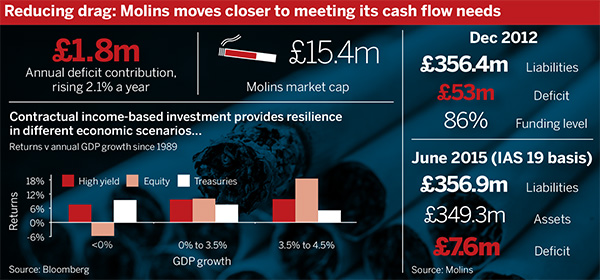Cigarette manufacturing company Molins has revised its investment strategy to reduce costs and focus on outgoings rather than capital growth, as many defined benefit schemes creep closer to being cash-flow negative.
Around half of FTSE 350 schemes are in negative territory or soon will be, according to recent figures from consultancy Hymans Robertson. The schemes are paying out £13bn a year more than they receive in contributions, a figure expected to rise to £50bn by 2030.
The £350m Molins UK Pension Fund began the overhaul following its 2012 triennial valuation. Chair of trustees Nigel Cobby said it was anxious not to become a forced seller of assets in order to cover its liabilities.
“It weakens the fund to the point where you can’t get to your end point,” he said. “What we decided to do was concentrate on the cash flow of the fund rather than the cash generation.”
The scheme reduced its equity exposure in order to diversify its investments, increasing exposure to inflation-linked assets, moving into higher-income producing property and diversified income funds.

The process took around two years. "We were learning as we went along,” Cobby said.
Reducing risk and cost
Molins’ second objective was to derisk and reduce the cost of running the scheme. Using funding triggers, it will gradually decrease growth assets and move into index-linked bonds or liability-driven investments.
If we can broadly match those outgoings with the cash incoming and reduce the risk of the fund, we ought to be around to pay that last member
Nigel Cobby, Molins
Molins also turned its attention to investment costs. Cobby said a proportion of many funds is allocated to passive assets, “so you’re paying high fees for partial management... So we thought, let’s see if we can replicate this.”
Cobby said the scheme’s new strategy has created savings of around £500k a year and has reduced risk.
He added: “If we can broadly match those outgoings with the cash incoming and reduce the risk of the fund, we ought to be around to pay that last member.”
Diversified income
John Walbaum, head of investment consulting at Hymans Robertson, said schemes approaching cash flow negativity need to ensure they can generate income without being a forced seller.
“To do that, investing in assets that will deliver the income needed to pay today’s and tomorrow’s pensioners is key. Yet only 4 per cent of schemes see this as a priority,” he said.
Walbaum said investment with “contractual cash flows” such as those with coupons and interest payments from bonds and loans offer more certainty for meeting liabilities.
Longer-term cash commitments from sponsors can also enable significant investment strategy derisking, “even if this means less cash for longer with less risk”.
If the FTSE 350 adopted this approach, Walbaum explained, it could increase benefit security by £25bn.
He added: “Crucially, cash flow risk is becoming ever more significant and is clearly not on trustees’ radar. It needs to be a key component of all risk management strategies.”
However Murray Taylor, senior consultant and head of manager research at consultancy JLT Employee Benefits, said the scope of diversified income funds is not as wide as it is for other multi-asset products.
He said: “The problem with diversified income funds is it does constrain the universe in which you can invest.”
Taylor said while most of his clients are looking for total return rather than income, smaller schemes might be drawn to diversified income funds to reduce their administrative burden.
But Simeon Willis, principal consultant at KPMG, said broadening out bond mandates can offer a “world of opportunity” for schemes.
He said: “Diversified credit funds, and in particular absolute return bond funds, offer schemes a means of accessing a very broad range of fixed income and contractual assets, without the undesirable interest rate exposure.”














